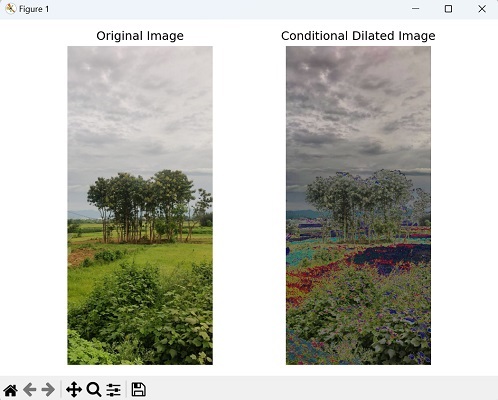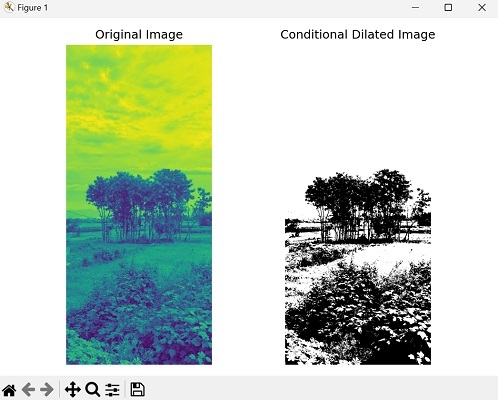
- Mahotas 教程
- Mahotas - 首頁
- Mahotas - 簡介
- Mahotas - 計算機視覺
- Mahotas - 歷史
- Mahotas - 特性
- Mahotas - 安裝
- Mahotas 影像處理
- Mahotas - 影像處理
- Mahotas - 載入影像
- Mahotas - 以灰度載入影像
- Mahotas - 顯示影像
- Mahotas - 顯示影像形狀
- Mahotas - 儲存影像
- Mahotas - 影像質心
- Mahotas - 影像卷積
- Mahotas - 建立RGB影像
- Mahotas - 影像尤拉數
- Mahotas - 影像中零的比例
- Mahotas - 獲取影像矩
- Mahotas - 影像區域性最大值
- Mahotas - 影像橢圓軸
- Mahotas - 影像拉伸RGB
- Mahotas 顏色空間轉換
- Mahotas - 顏色空間轉換
- Mahotas - RGB到灰度轉換
- Mahotas - RGB到LAB轉換
- Mahotas - RGB到褐色轉換
- Mahotas - RGB到XYZ轉換
- Mahotas - XYZ到LAB轉換
- Mahotas - XYZ到RGB轉換
- Mahotas - 增加伽馬校正
- Mahotas - 拉伸伽馬校正
- Mahotas 標記影像函式
- Mahotas - 標記影像函式
- Mahotas - 標記影像
- Mahotas - 過濾區域
- Mahotas - 邊界畫素
- Mahotas - 形態學操作
- Mahotas - 形態學運算元
- Mahotas - 查詢影像平均值
- Mahotas - 裁剪影像
- Mahotas - 影像偏心率
- Mahotas - 影像疊加
- Mahotas - 影像圓度
- Mahotas - 調整影像大小
- Mahotas - 影像直方圖
- Mahotas - 膨脹影像
- Mahotas - 腐蝕影像
- Mahotas - 分水嶺演算法
- Mahotas - 影像開運算
- Mahotas - 影像閉運算
- Mahotas - 填充影像空洞
- Mahotas - 條件膨脹影像
- Mahotas - 條件腐蝕影像
- Mahotas - 影像條件分水嶺演算法
- Mahotas - 影像區域性最小值
- Mahotas - 影像區域最大值
- Mahotas - 影像區域最小值
- Mahotas - 高階概念
- Mahotas - 影像閾值化
- Mahotas - 設定閾值
- Mahotas - 軟閾值
- Mahotas - Bernsen區域性閾值化
- Mahotas - 小波變換
- 製作影像小波中心
- Mahotas - 距離變換
- Mahotas - 多邊形工具
- Mahotas - 區域性二值模式
- 閾值鄰域統計
- Mahotas - Haralic特徵
- 標記區域的權重
- Mahotas - Zernike特徵
- Mahotas - Zernike矩
- Mahotas - 排序濾波器
- Mahotas - 二維拉普拉斯濾波器
- Mahotas - 多數濾波器
- Mahotas - 均值濾波器
- Mahotas - 中值濾波器
- Mahotas - Otsu方法
- Mahotas - 高斯濾波
- Mahotas - Hit & Miss變換
- Mahotas - 標記最大值陣列
- Mahotas - 影像平均值
- Mahotas - SURF密集點
- Mahotas - SURF積分影像
- Mahotas - Haar變換
- 突出顯示影像最大值
- 計算線性二值模式
- 獲取標籤邊界
- 反轉Haar變換
- Riddler-Calvard方法
- 標記區域的大小
- Mahotas - 模板匹配
- 加速魯棒特徵
- 去除帶邊框的標記
- Mahotas - Daubechies小波
- Mahotas - Sobel邊緣檢測
Mahotas - 條件膨脹影像
在上一章中,我們探討了影像膨脹的概念,這是一種用於將影像中區域的所有畫素擴充套件到邊界的操作。另一方面,條件膨脹根據某些條件擴充套件特定區域的畫素。
條件可以基於影像畫素的強度值或影像中的某些特定模式。
例如,讓我們考慮一個灰度影像。您可以有條件地僅膨脹滿足特定強度閾值的畫素,而不是膨脹所有前景畫素。
如果畫素的強度高於預定義的閾值,則應用膨脹;否則,畫素保持不變。
在Mahotas中進行條件膨脹影像
在Mahotas中,條件膨脹是傳統膨脹操作的擴充套件,它包含基於第二張影像(通常稱為“標記影像”)的條件。
它允許您控制膨脹過程,以便膨脹僅在標記影像具有特定畫素值的位置發生。
我們可以使用cdilate()函式在Mahotas中對影像執行條件膨脹。此函式根據標記影像的畫素值將膨脹過程限制在特定區域。
mahotas.cdilate()函式
Mahotas中的cdilate()函式接受兩個輸入——輸入影像和掩碼(條件)陣列。它根據提供的條件對輸入影像執行條件膨脹,並返回生成的膨脹影像。
掩碼用於識別影像內的特定區域。它們充當過濾器,突出顯示某些區域,而忽略其他區域。
語法
以下是cdilate()函式的基本語法:
mahotas.cdilate(f, g, Bc={3x3 cross}, n=1)
其中,
f - 它是將執行條件膨脹的輸入影像。
g - 它是條件膨脹期間要應用的掩碼。
Bc = {3×3十字} (可選) - 它是用於膨脹的結構元素。預設為{3×3十字}。
n - 它是膨脹操作的迭代次數。預設情況下,它設定為1,表示單次迭代。
示例
在下面的示例中,我們透過放大畫素強度來對影像執行條件膨脹:
import mahotas as mh
import numpy as np
import matplotlib.pyplot as plt
image= mh.imread('nature.jpeg')
g = image * 2
conditional_dilated_image = mh.cdilate(image, g)
# Create a figure with subplots
fig, axes = plt.subplots(1, 2, figsize=(7,5 ))
# Display the original image
axes[0].imshow(image)
axes[0].set_title('Original Image')
axes[0].axis('off')
# Display the conditional dilated image
axes[1].imshow(conditional_dilated_image, cmap='gray')
axes[1].set_title('Conditional Dilated Image')
axes[1].axis('off')
# Adjust the layout and display the plot
plt.tight_layout()
plt.show()
輸出
執行上述程式碼後,我們將得到以下輸出:

使用結構元素
要在Mahotas中使用結構元素執行條件膨脹,首先,我們需要定義將應用膨脹的條件。例如,您可以根據畫素強度指定條件或提供二值掩碼。
接下來,選擇一個定義膨脹鄰域的結構元素。Mahotas提供了幾個預定義的結構元素,例如圓盤和正方形,您可以根據所需的形狀和大小選擇它們。
最後,檢索生成的影像,其中將僅包含滿足條件的膨脹效果。
示例
在這裡,我們嘗試使用結構元素對影像執行條件膨脹:
import mahotas as mh
import numpy as np
import matplotlib.pyplot as plt
image= mh.imread('nature.jpeg', as_grey = True).astype(np.uint8)
# Define the condition based on pixel intensity
condition = image > 100
# Define a structuring element for dilation
structuring_element = mh.disk(5)
conditional_dilated_image = mh.cdilate(image, condition, structuring_element)
# Create a figure with subplots
fig, axes = plt.subplots(1, 2, figsize=(7,5 ))
# Display the original image
axes[0].imshow(image)
axes[0].set_title('Original Image')
axes[0].axis('off')
# Display the conditional dilated image
axes[1].imshow(conditional_dilated_image, cmap='gray')
axes[1].set_title('Conditional Dilated Image')
axes[1].axis('off')
# Adjust the layout and display the plot
plt.tight_layout()
plt.show()
輸出
獲得的輸出如下所示:

使用自定義條件函式
我們還可以使用自定義條件函式對影像執行條件膨脹。
為此,我們首先定義一個自定義條件函式,該函式確定哪些畫素應該進行膨脹。
接下來,選擇一個結構元素來定義膨脹操作的形狀和大小。
最後,執行條件膨脹並檢索膨脹後的影像。
示例
現在,我們使用自定義條件函式膨脹影像:
import mahotas as mh
import numpy as np
import matplotlib.pyplot as plt
# Load image
image = mh.imread('sea.bmp', as_grey=True).astype(np.uint8)
# Define a custom condition function
def custom_condition(pixel_value):
return pixel_value > 100
# Define a structuring element
structuring_element = mh.disk(5)
# Create a binary mask based on the custom condition function
condition = custom_condition(image)
# Perform conditional dilation
conditional_dilated_image = mh.cdilate(image, condition, structuring_element)
# Create a figure with subplots
fig, axes = plt.subplots(1, 2, figsize=(7,5 ))
# Display the original image
axes[0].imshow(image)
axes[0].set_title('Original Image')
axes[0].axis('off')
# Display the conditional dilated image
axes[1].imshow(conditional_dilated_image, cmap='gray')
axes[1].set_title('Conditional Dilated Image')
axes[1].axis('off')
# Adjust the layout and display the plot
plt.tight_layout()
plt.show()
輸出
以下是上述程式碼的輸出:
